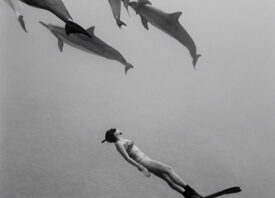Search this site
Rare and Ancient Creatures Revealed in Underwater Photography

“Exploring the strange and wild world of hellbenders is nothing short of science fiction,” David Herasimtschuk, a conservation photographer specializing in freshwater environments, says. These ancient salamanders, whose presence in mountain streams dates back more than 160 million years, can grow to more than two feet long—though their wrinkled skin does a good job of blending in with their surroundings. The untrained eye might, at first, mistake a hellbender for a large rock, but Herasimtschuk’s underwater photography reveals their astonishing beauty.
“The hellbender salamander is one of the most bizarre animals found on this planet,” the photographer says. “These unusual characteristics make this living fossil one of the most beautiful and important river creatures you will ever see.”
But hellbenders are in trouble. These animals breathe through their wrinkly skin, so they’re heavily dependent on water quality; when that water quality suffers—due to agricultural activity, pollution, and harmful chemicals—the hellbenders do too. Researchers have found that hellbender populations have been dropping since the 1980s.
As a child, Herasimtschuk fell in love with freshwater ecosystems while growing up near Cache la Poudre River in Colorado, where he spent countless hours observing the toads. For more than a decade now, Herasimtschuk has worked with Freshwaters Illustrated, a nonprofit raising awareness about aquatic environments. In that time, he’s come face-to-face with countless fish and amphibians across the continent.
Once, while underwater in Tennessee’s Tellico River, Herasimtschuk discovered a hellbender clasping a snake in its jaws. The snake escaped, and the moment left the photographer with a renewed sense of awe and wonder. “Incredible worlds that can be found right beneath the surface of our our rivers and streams,” he explains. “Often forgotten, these environments harbor creatures beyond our imagination, with many of them occurring right in our own backyards.”
We asked Herasimtschuk to tell us more about his underwater photography, his work on behalf of freshwater ecosystems, the threats our rivers are facing, and what can be done to help.

You have a background in freshwater ecology. In what ways does this experience inform your work in underwater photography?
“I attended Colorado State University from 2002-2007 and studied Wildlife and Fishery Biology. During my time in college, I gained a much greater appreciation for freshwater and was introduced to the unique diversity of life that inhabited these threatened ecosystems. College was also the point where I picked up my first camera, and it wasn’t long after that that I really started to see the power of photography as a tool for creating awareness surrounding freshwater conservation.
“But I also began to realize that there was very little documentation of freshwater life in its natural habitat. As a young aspiring photographer, I scoured the pages of wildlife photography books and magazines trying to learn and absorb as much as possible, yet as inspiring as that imagery was, very rarely did I find images that captured freshwater diversity the way I knew it to be.
“After college, I worked on a series of freshwater-related research projects but continued photography along the way. I was truly fortunate to get to travel, study, and photograph freshwater environments in many parts of the world. Through my work, I often saw a recurring theme. All communities have incredibly strong ties and values associated with freshwater, yet most never realize how unique and special these environments are from a diversity perspective. There is a huge disconnect between what lives in freshwater environments and what is perceived to live in them.
“Over the last fifteen years, I’ve been truly fortunate to spend a great deal of time photographing the freshwater life of our planet. The experience and knowledge I gained as a freshwater ecologist and researcher have helped me discover novel techniques for communicating the complexities and connections that occur within freshwater ecosystems, and how science communication can play a role in protecting them. I’ve been fortunate to collaborate with many of the top freshwater scientists in the world.”


What makes freshwater ecosystems unique? In what ways are they different from other marine environments?
“For much of the diversity inhabiting the earth, freshwater is essential for survival. The rivers, streams, wetlands, and lakes that shape the surface of our planet are the foundation of life as we know it. A true spectacle of biodiversity, freshwater hosts a surprising collage of colors, shapes, and behaviors, and supports one of the richest—yet little-known—pools of biodiversity found on the planet.
“Life flourishes within these environments, which represent less than one percent of the Earth’s water but still harbor nearly half of all fish species worldwide. Much of this great aquatic diversity resides in the tropical regions of the world, with the most speciose waters occurring in the Amazon, Congo, and Mekong river basins.
“There are also many unique assemblages of freshwater life that can be found right in our own backyards. In the southeastern US alone, nearly 500 species of fish inhabit the freshwater environments in the region. Arguably just as diverse as marine ecosystems, these aquatic worlds harbor thousands of species showcasing a teeming collection of life that few have ever seen or known.
“These unique aquatic species also play a critical part in our everyday lives. There are numerous freshwater organisms that play a critical role in cleaning water. From lamprey and beavers to mussels and shrimp, these important organisms spend part of their lives as mini-water treatment plants filtering water that eventually gets used by humans.
“From clean water and food production to the core of our very well-being as humans, freshwater is beyond just a natural resource. It is vital to our very existence. As humans, our everyday lives are sustained by the behaviors and interactions of freshwater organisms and ecosystems.
“Yet, because these processes and relationships occur in places and at scales rarely observed, our connection with freshwater biodiversity and the role it plays in nurturing our well-being often goes completely unnoticed.
“Currently, freshwater extinction rates exceed that of both marine and terrestrial ecosystems by double, yet these ecosystems receive very little attention from the media and in the decision-making process. As the movement to conserve rivers continues to gain momentum worldwide, recognizing the importance of native aquatic biodiversity is critical to protecting freshwater environments.
“Just as we fight for free rivers and the removal of dams, we should also be fighting for the protection of our native species. Our failures to see the intrinsic and ecological values of native freshwater life have come at great cost to many species. In our quest to manage and manipulate freshwater ecosystems, we put economy and recreational values above ecological values, and we are now seeing the consequences.”


When creating underwater photography for conservation, what ethical rules do you follow?
“Due to the complicated and consequential nature of freshwater storytelling, ethics are critical to accurately documenting and disseminating the information and imagery captured. I work directly with science and conservation partners to make sure all stories, photo essays, and educational materials produced, accurately represent the current research and understanding of freshwater science and conservation.
“I also strive to exercise the utmost caution and respect when photographing wildlife, and I place the well-being of the animal above all else. When working directly with Federally protected species, I rely on the guidance and regulations of agency partners and biologists to minimize the stress that might incur on the subject or sensitive habitats.
“Given all the manipulation that occurs with photos these days, I believe it’s extremely important to be fully transparent in captioning, providing editors and audiences information on exactly how images are made.”

What steps do you take to ensure that you don’t harm especially vulnerable ecosystems while practicing underwater photography?
“Freshwater ecosystems are increasingly susceptible to a growing number of impacts, so it’s important to understand how our daily actions might affect an environment or species. One threat that often goes completely unnoticed within freshwater environments is disease. With more people entering outdoor spaces these days, there is an ever-growing threat of wildlife disease spreading into new locations and habitats, without anyone realizing the potential impact.
“In what is often described as the most destructive wildlife disease, amphibian chytrid fungus (Batrachochytrium dendrobatidis) has had a disastrous impact on amphibian species and freshwater environments worldwide, yet very few even know of its existence.
“Recent studies have shown that the decline of amphibians, as a result of a fungal pathogen, has caused the greatest loss of biodiversity from a disease ever recorded. The skin-eating fungus has spread to every continent where amphibians are found, and has caused the decline of 501 species of amphibian and resulted in the extinction of 90 species.
“While it may seem hopeless to stop this silent killer, there are actions we can take in our everyday lives to slow the spread of wildlife disease and limit the movement of new pathogens.
“A couple ways everyone can help protect amphibians are listed below.
- If you are recreating in areas that involve contact with mud or water, especially internationally, please consider adopting basic field-disinfecting measures and make sure to thoroughly clean all shoes and equipment.
- Report any sightings of sick or dead amphibians to local biologist or simply send an email to this address – [email protected]
- It’s also extremely important to not release pet amphibians into the wild, and this includes backyards. Certain captive species can carry chytrid, but not show signs of the infection, so releasing them could have detrimental impacts on wild amphibian populations.
“These simple steps can have a huge impact on our local freshwater environments. Personally, I make sure to disinfect all my gear and equipment before I recreate or work in a new area. This is often as easy as applying a 10 percent bleach solution to the bottom of my shoes to make sure I’m not spreading any unwanted pathogens. These small steps are extremely important as new diseases show up each year.
“Recently, researchers discovered a new fungal pathogen known as Batrachochytrium salamandrivorans or Bsal. The current spread of Bsal is a major threat to the world’s salamander diversity, in much the same way that amphibian chytrid fungus has devastated frog and toad numbers.
“Bsal has decimated populations of salamanders in Europe, and biologists and agencies have recently taken protective measures and preparations for the potential spread of Bsal in North America, where it has not yet been detected.
“There is now a serious need to raise awareness about Bsal’s threats and precautions. The consequences of Bsal invading North America, which supports some of the greatest salamander diversity on the planet, would be severe and irreversible, as it is known to be fatal to many species.
“The unfortunate reality from many biologists I have spoken with is not if Bsal will spread to North America, but rather when. So it’s important to have a set of tools and a response plan for any scenario. Education is definitely the first line of defense.
“This proactive approach has the ability to help inspire actions that people can take in their own everyday lives to help conserve these vital species. If more people are out there recreating responsibly, and helping to prevent the movement of Bsal the chances of it actually spreading are reduced.
“If Bsal does make it to North America, education and outreach will play a major role in preventing its spread. Many biologists worry that the disease might not be discovered right away, so the more people that are out keeping an eye out for salamanders, the greater chance we have to slow the spread and minimize the pathogen’s reach.”
Can you tell me a bit about Freshwaters Illustrated and the work they do?
“FI is a non-profit organization that uses film and photography to educate the public on a variety of freshwater topics. We strive to create imagery that has the power to not only capture the imagination of the public but also help to motivate a new discourse in the way we all view freshwater ecosystems.
One of only a few organizations in the world that focus strictly on freshwater storytelling, FI’s devotion to celebrating the life below the surface has resulted in a newly cultivated awareness in the way many view the planet’s freshwater ecosystems. Our photos and films on enigmatic species, like Pacific Lamprey, freshwater shrimp, and salamanders have not only educated the public on the intrinsic and ecological values of these species but have also helped gain support for their protection and preservation of habitats.”

What are some of the most significant challenges facing our freshwater ecosystems, and what can we do to help?
“As human populations continue to grow, freshwater environments are repeatedly altered from their wild nature to aid the rising demands of a changing world. Numerous deleterious threats, including water extractions, pollution, invasive species, habitat destruction, and the constant proliferation of dams, continue to degrade freshwater ecosystems. It’s been estimated that wetland habitat has decreased by almost 70%, and many of the planet’s iconic freshwater environments have suffered tremendously from these impacts.
“The conflict between freshwater management and environmental health is also becoming a serious threat to the state of freshwater biodiversity worldwide. Populations of freshwater vertebrates have declined by over 80 percent since 1970, with almost 1/3 of all freshwater fish species facing extinction.
“As freshwater environments are manipulated for human use, the environmental problems often associated with impacts, like water regulation, habitat alteration, and pollution, are often overlooked. The anthropogenic burden placed on many of these ecosystems comes at huge costs to the life that resides there, and with very few exploring freshwater from an aquatic perspective, it’s often very difficult to effectively communicate what we stand to lose.
“There are numerous ways one can help protect freshwater environments. From volunteering with watershed councils and environmental organizations to practicing water conservation, engaging locally is a great way to learn more about where your water comes from and how you can help protect it.
“Given the immediacy of many of these issues, it’s also important to engage civically. Voting for legislation that increases the protection of natural areas, wildlife, and clean water initiatives, not only benefits freshwater ecosystems but also the many species that rely on them, including humans.”

Have you seen any of these challenges up-close while creating underwater photography for Freshwaters Illustrated?
“While I love sharing and celebrating the beauty of freshwater life and environments, a large part of my work also involves documenting how freshwater ecosystems are being impacted by the actions of humans. Many of the river systems I document have suffered tremendously from human management and overuse. One of the current projects that I’m working on with Freshwaters Illustrated in the Southwestern United States is a great example of the immensity of change that humans can introduce to a river system.
“Few rivers illustrate the complexities of our dependence on freshwater better than the Colorado River. Supplying water to seven states, two countries, and over 40 million people, the systematic overuse of this river and its tributaries has resulted in an unsustainable system that is beginning to fail.
“Exacerbated by the worst drought in the region in 1,200 years, and the increasing impacts of climate change, there is an immediate demand for governments and water managers to find new ways of conserving and sharing water within the region.
“While this important issue has seen a large amount of attention in recent years, much of the media coverage fails to communicate the extent of environmental impacts that have resulted from anthropogenic change within the watershed. With so much of the narrative focused on the control of water resources and the political discourse that has resulted, there is a growing need to recognize the ecological crisis facing the environments and biodiversity of the Colorado River Basin.
“Historically, the Colorado River Basin supported one of the most unique assemblages of freshwater fish communities in the world. Of the 49 native freshwater fishes that inhabit the watershed, 42 are found nowhere else on the planet, resulting in some of the highest rates of endemism in North America.
“Currently, the indigenous fish fauna of America’s desert Southwest represents one of the most imperiled groups of native fauna on the continent. Along with over a hundred years of large-scale water development projects, native freshwater species have been impacted by the introduction of over 70 non-native fish species within the watershed. Biologists now estimate that basin-wide, 95% of all fish found in the Colorado River are non-native.
“In Arizona alone, 20 out of the 36 native fish species that occur in the state are listed under the Federal Endangered Species Act, yet very few people have ever heard of or seen this unique assemblage of fish.
“With negotiations and decisions currently being made to address the future water management actions within the basin, it is vital that the public and policymakers have the tools and information necessary to make informed decisions about how freshwater environments are managed in the Southwest. The decisions these communities make in regard to water management will have considerable impacts on native biodiversity and ecosystems in the future.”


What moments have given you hope for the future of conservation?
“One of the favorite parts of my job is connecting with and documenting the stories of passionate individuals who spend their lives working to conserve and protect freshwater life and environments. Their inspiring dedication is often a strong motivating force in my life and one of the reasons I work hard to share freshwater stories with the rest of the world.
“While working as a freshwater photographer, I have documented many positive and hopeful stories. In the Pacific Northwest, I have witnessed communities set aside their differences and come together to restore and protect their local watersheds. With loggers and farmers so often portrayed at odds with the conservation community, here they are working together pragmatically, in ways that are mutually beneficial and result in the ecological recovery of watersheds.
“In the Southeastern US, I have seen species returned to rivers with the help of numerous ongoing reintroduction programs that are aimed at reintroducing native freshwater fishes, amphibians, and invertebrates, including the recovery of some species once thought to be extinct. The efforts of groups like Conservation Fisheries, Inc. and the Tennessee Aquarium Conservation Institute, which are organizations dedicated to breeding, raising, and reintroducing threatened and endangered aquatic species, have brought life back to many of these streams.
“As the demand for freshwater continues to grow, documenting our ability to conserve healthy aquatic ecosystems, has the power to send a positive message to the rest of the world. In a future with changing aquatic ecosystems, and less water, we do have the ability to adapt and conserve our freshwater environments.”

For more underwater photography with a focus on conservation, check out Karen Glaser’s work on marine life in Florida.



